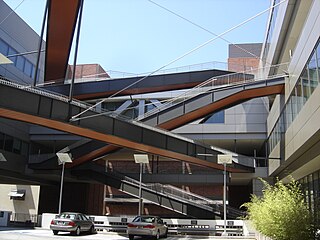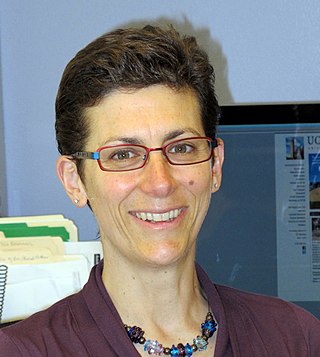Related Research Articles

The University of California, Santa Barbara is a public land-grant research university in Santa Barbara County, California, United States. It is part of the University of California university system. Tracing its roots back to 1891 as an independent teachers' college, UCSB joined the ancestor of the California State University system in 1909 and then moved over to the University of California system in 1944. It is the third-oldest undergraduate campus in the system, after UC Berkeley and UCLA. Total student enrollment for 2022 was 23,460 undergraduate and 2,961 graduate students.

The College of Creative Studies (CCS) is the smallest of the three undergraduate colleges at the University of California, Santa Barbara, unique within the University of California system in terms of structure and philosophy. Its small size, student privileges, and grading system are designed to encourage self-motivated students with strong interests in a field to accomplish original work as undergraduates. A former student has called it a “graduate school for undergraduates”. The college has roughly 350 students in nine majors and approximately 60 professors and lecturers. There is an additional application process to the standard UC Santa Barbara admission for prospective CCS students, and CCS accepts applications for admissions throughout the year.
Arthur C. Gossard was a professor of materials and electrical engineering at the University of California, Santa Barbara. In 1982, he co-discovered the fractional quantum Hall effect. His research is related to molecular beam epitaxy (MBE). He has a doctorate in physics from UC Berkeley. After university, he joined Bell Labs.
Harold Marcuse is an American professor of modern and contemporary German history and public history. He teaches at the University of California, Santa Barbara. He is the grandson of philosopher Herbert Marcuse.

The University of California, Santa Barbara Library is the university library system of the University of California, Santa Barbara in Santa Barbara, California. The Library includes four facilities: Two libraries and two annexes. The library has some three million print volumes, 30,000 electronic journals, 34,450 e-books, 900,055 digitized items, five million cartographic items, more than 3.7 million pieces of microform, 167,500 sound recordings, and 4,100 manuscripts. The Library states that it holds 3.2 miles (5.1 km) of manuscript and archival collections.
Emma Lou Diemer is an American composer.

The Art, Design and Architecture Museum is located on the campus of the University of California, Santa Barbara in Santa Barbara, California, United States.

The College of Engineering (CoE) is one of the three undergraduate colleges at the University of California, Santa Barbara.

The California NanoSystems Institute (CNSI) is an integrated research center operating jointly at UCLA and UC Santa Barbara. Its missions are to foster interdisciplinary collaborations for discoveries in nanosystems and nanotechnology; train the next generation of scientists, educators and technology leaders; and facilitate partnerships with industry, fueling economic development and the social well-being of California, the United States and the world.

The Cheadle Center for Biodiversity and Ecological Restoration (CCBER) is a research center under the Office of Research at the University of California, Santa Barbara (UCSB) whose mission is to preserve regional biodiversity and restore ecosystems on campus lands. CCBER has three main functions: curation and preservation of natural history collections, native coastal ecosystem and habitat restoration on campus lands, and education and outreach for both UCSB students and local community schools.

The AlloSphere is a research facility in a theatre-like pavilion in a spherical shape, of opaque material, used to project computer-generated imagery and sounds. Included are GIS, scientific, artistic, and other information. Located at the University of California, Santa Barbara (UCSB) the AlloSphere grew out of the schools of electrical engineering and computer science, and the Media Arts & Technology program at UCSB.
The Center for Information Technology and Society at the University of California, Santa Barbara was founded in 1999 to support the interdisciplinary study of the cultural transitions and social innovations associated with contemporary information technology. CITS accomplishes this by connecting scholars in different disciplines studying similar phenomena related to technology and society, through both formal events and informal meetings of the center's faculty research affiliates. Currently, CITS faculty represent 13 departments on campus, spanning the Social Sciences, the College of Engineering, and the Humanities. In addition, the center supports graduate study through the administration of the Technology & Society Emphasis on campus. CITS is housed in the campus Office of Research, as a unit of the Institute for Social, Behavioral, and Economic Research at the university.
The Center for Nanotechnology in Society at the University of California at Santa Barbara (CNS-UCSB) is funded by the National Science Foundation and "serves as a national research and education center, a network hub among researchers and educators concerned with societal issues concerning nanotechnologies, and a resource base for studying these issues in the US and abroad." The CNS-UCSB began its operations in January 2006.
The Physics Department at the University of California, Santa Barbara has 58 faculty members. It offers academic programs leading to the B.A., B.S., and Ph.D. degrees.
The College of Letters and Science is the largest college at the University of California, Santa Barbara. The College, which offers 90 majors and 38 minors to over 20,000 undergraduates and 2,000 graduate students, has about 700 faculty members.
Megan T. Valentine is an American engineer. She is a professor of mechanical engineering at the University of California, Santa Barbara and associate director of the California NanoSystems Institute. Valentine's research focuses on understanding how forces are generated and transmitted in living materials and how they control cellular outcomes. Valentine is a Fellow of the American Physical Society and the American Institute for Medical and Biological Engineering.
The Institute for Energy Efficiency (IEE) is a research institute of the University of California, Santa Barbara (UCSB). IEE is an interdisciplinary research institute dedicated to the development of science and technologies that increase energy efficiency, reduce energy consumption, and support an efficient and sustainable energy future.

Linda Adler-Kassner is an educator and university administrator. She is known for her work in the field of writing studies, including co-authoring Naming What We Know: Threshold Concepts of Writing Studies, which was recognized by the Council of Writing Program Administrators.
References
- 1 2 3 Hinkle-Turner, Elizabeth (2006). Women Composers and Music Technology in the United States. Ashgate Publishing. p. 95. ISBN 9780754604617.
Kuchera-Morin (b. 1951) ... Ph.D. in composition from the Eastman School of Music (1984) ... B.M. in composition and theory and M.M. in composition were earned at Florida State University
- 1 2 " "Media, Arts, and Technology: JoAnn Kuchera-Morin". Create.UCSB.edu.
- ↑ " "People". AlloSphere.UCSB.edu. Archived from the original on 2014-10-06. Retrieved 2014-10-06.
- 1 2 "Speakers: JoAnn Kuchera-Morin". TED.com.
- ↑ "UC DIGITAL MEDIA INNOVATION PROGRAM ANNOUNCES "DIGIVATIONS" EVENT AND FORMATION OF THINK TANK". 8 September 2000. Retrieved 2015-09-15.
- ↑ "Jo Ann Kuchera-Morin". UC Santa Barbara School of Music. Retrieved 2015-08-09.
- ↑ "Mentors: Dr. JoAnn Kuchera-Morin". XMediaLab.com. Archived from the original on 2014-10-06. Retrieved 2014-10-06.
- ↑ Roads, Curtis (2004). Microsound, p.318. MIT Press. ISBN 9780262681544.